Chinese Tea Leaf Eggs
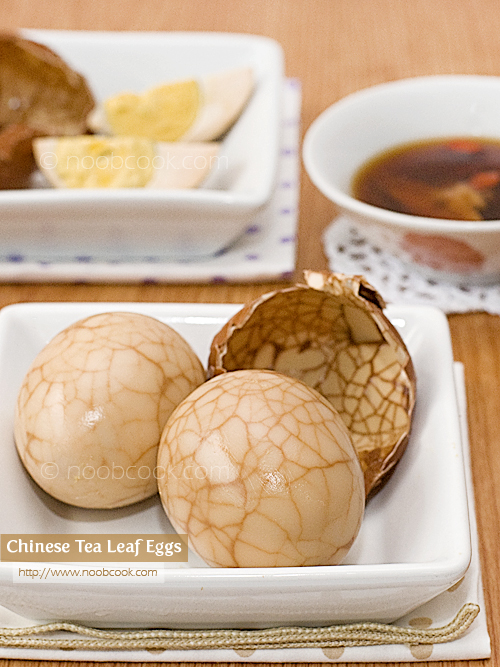
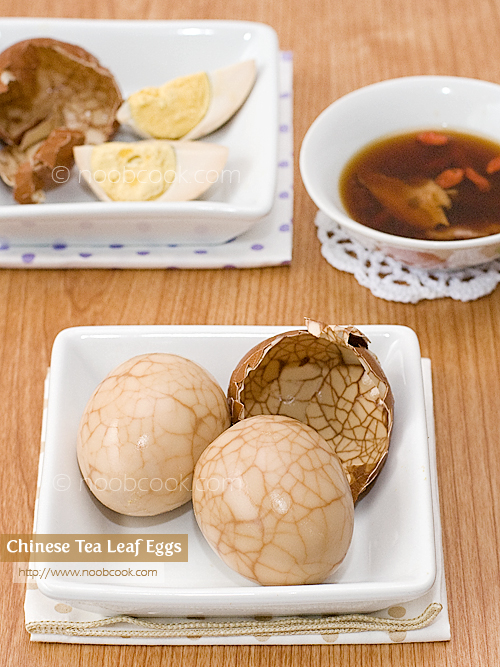
Tea Leaf Eggs: Popular savoury street snack recreated at home
Chinese tea leaf eggs (also known as Chinese Marbled Eggs, Tea Leaf Eggs, Cha Ye Dan, 茶叶蛋/茶葉蛋) is a common street delight in Asia, including Singapore. They are really easy to make at home, especially when you use a slow cooker. I basically made some (almost) hard boiled eggs, made cracks all over the shells while leaving them intact, then I dump them into a slow cooker with some ingredients and let the slow cooker do its magic. Really super easy. If you do not have a slow cooker, you can simmer them in a soup pot. The kitchen, to my delight, is filled with the wonderful aroma of tea, herbs and spices – my kind of aromatherapy. It felt as if I had walked past a Chinese medical hall. One common complaint about tea leaf eggs I hear is that while the aroma smells superb when you walk past a shop selling them, they taste quite bland when you bite into it. I think the ones I made are quite savoury and yummy.
If you noticed that my tea leaf eggs are not as dark as the usual ones, that’s because I took them out sooner to snap photos before the sun sets. If you like the darker colour, add more dark soy sauce and simmer as long as you can.
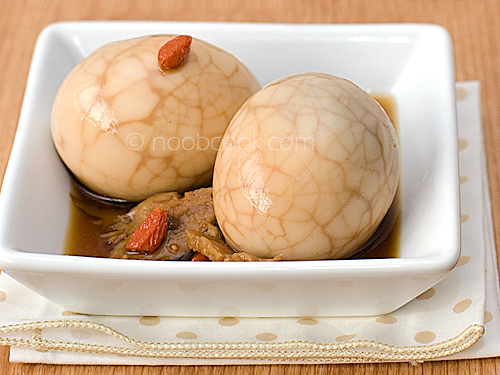
Serving suggestion: eggs in herbal (dang gui and wolfberries) broth
Ingredients
– Eggs (any number, but make sure they cover only one layer in the pot)
– Boiling water
– 100ml light soy sauce
– 1 tsp dark soy sauce (add more if you prefer a darker colour)
– 1 tsp sugar(A) Herbs and Spices
– 2 tbsp black, non-floral tea (preferably Chinese tea such as pu-er 普洱, tie guan yin 铁观音 or oolong 乌龙) or 2 black tea leaves bag (if using tea bag, only use the tea filter bag, cut away the string and paper handle)
– 1 cinnamon stick
– 2 star anise
– 2 small pieces of dried tangerine/orange peel
– 3 cloves
– 6 peppercorns, lightly bruised
– 2 small pieces of dang gui aka Angelica sinensis, Chinese Angelica Root, 当归 (optional, for the herbal taste)For extra herbal taste (optional, for step 4 below)
– 5 pieces of dang gui
– 1 tsp wolfberries, soaked in water for at least 5 minutesDirections
1. Prepare hard boiled eggs till they are 80% cooked. To do that, place eggs in saucepan of cold water (enough water to cover eggs). Bring to a boil for about 2 minutes, off the flame and cover with lid for about 7 minutes (for 100% hard boiled eggs, it’s about 10 minutes). Rinse the eggs with cold water till they are cooled.
2. Gently tap the exterior of the eggs with the back of the spoon to form cracks evenly around the egg, careful to leave the entire shell still intact and covering the egg. This will create the beautiful “marbled” look and also allow the flavours to seep through the eggs.
3. In a slow cooker, arrange the eggs to occupy one layer in the pot. Then add boiling water (just enough to cover the eggs), soy sauces, sugar, tea and the ingredients in (A). Set the slow cooker on high for about 1-2 hours (starting from the time you see the water boiling in the slow cooker). Thereafter simmer on low for as long as you like till ready to serve. If you’re not using a slow cooker, just bring all the ingredients in a pot to a boil, then simmer for about 2-3 hours similar to how you prepare Chinese soups.
4. For extra herbal flavour, I added an extra 5 pieces of dang gui to the pot one hour before serving (I do not want to leave them in for too long as it will result in bitter taste). Five minutes before serving, add the soaked wolfberries. For this herbal version, I served the eggs in a shallow dish with some broth, wolfberries and dang gui pieces poured over it.
Gently tapping the eggs with the back of the spoon to form cracks
Cooking Notes
1. For easy cleaning and convenience, I place all the ingredients from (A) in a soup stock pouch. You can use the disposable type (I purchase a pack of 45 pieces at Daiso Singapore) or the re-usable stainless steel type.
2. When cutting the egg for serving, dip your knife blade in water first so that it does not stick to the egg yolk.
3. Do not heat up the whole eggs using a microwave as they will “explode”. Heat them up (with some of the broth) in a pot using a stove.
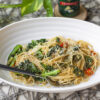
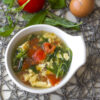
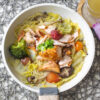
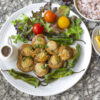
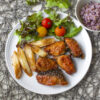
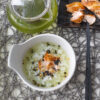

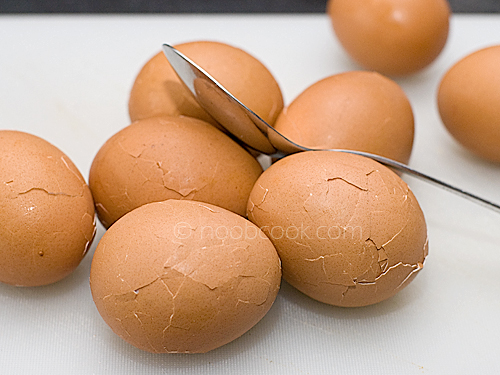
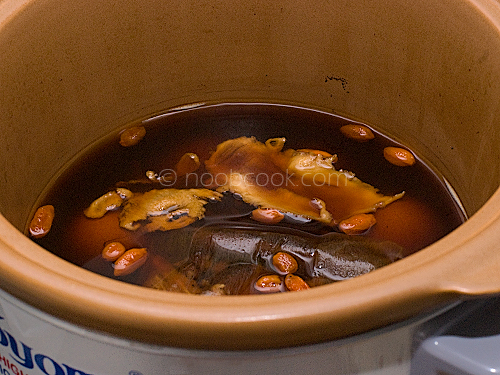

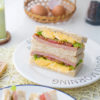

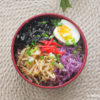

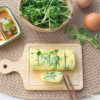
OMG never seen marbled eggs before, and they are beautiful!!! I’m gonna tell your tip about cracking them to my mom. :)
yes they must be not as common in western countries. Hey if you crack the eggs and dip them in edible (punchi) food dye colours instead, they will be so beautiful & punchi ;)
One of my childhood (and adult) favorites! I was wondering about the color. I like mine good and dark (and salty…eek!). These are so simple yet yummy, I don’t know why it’s been so long since I made them. Will have to try your recipe next time I do.
salty I like too! if you try my recipe, remember to increase the dark soy sauce since you like them dark :)
Yeah!!! Thanks for the recipe!!! I’ve been wanting to make some nice cha ye dan. :)
hi wiffy, if I were to use tea leaf bags, u mean we have to cut away the filter bag and only take the leafs in it? :)
can i know either this product ‘halal’ or not,tq.
hi azah, there’s no pork or lard (actually no meat) in the ingredients. Is that considered halal??
Recette très authentique, excellente explication. Mon entourage aime beaucoup et je suis ravie de les préparer ces oeufs au thé noir.
Hi wiffy, stupid question – as I don’t usually cook chinese dishes but where do I get all the herbs? Do I have to buy them in bulk?
I’m from Singapore, can find them at Chinese medical halls or supermarkets.
Pingback: 茶叶蛋 Tea Leaf Eggs | Treasury of Recipes
I was so surprised I was able to locate the recipes from google. more, to find out how easy to make it with step by step, detailed and picture instruction .
Thank you.
Pingback: Chinese Tea Leaf Eggs | Chun Wang